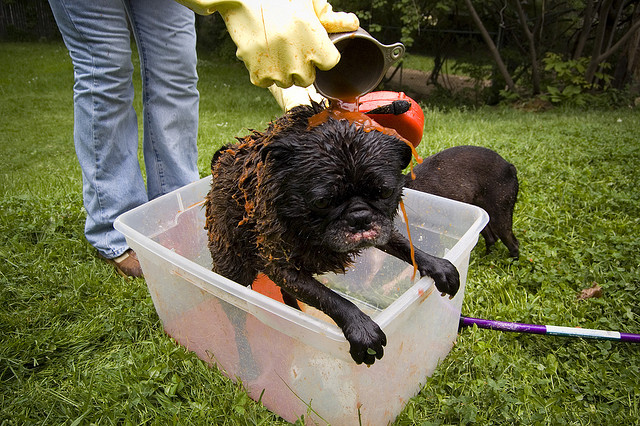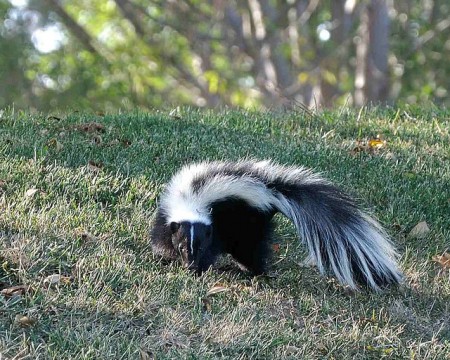New Health Risk for Dogs Who Get Skunked: Red Blood Cell Damage
Skunk spray toxicosis causes a reaction similar to the damage that onions and garlic can do in dogs, and it can even be fatal.

If you’ve smelled a skunk once, or if your dog has ever been “skunked,” it’s hard to forget the odor.
The classic rotten-egg smell is caused by a sulfur compound that is released when an “enemy” comes a little too close for comfort. The skunk’s main line of defense is the two anal glands on either side of its anus. When threatened, the skunk will first hiss and stomp. If the threat continues, the skunk will release its anal glands. Amazingly, skunks can spray up to 15 feet, and with great accuracy.
There are six species of skunks in the northern United States, all of which are easily identified by their black bodies and white stripes — and the nasty smell. Ironically, they have an excellent sense of smell (and hearing), but they cannot see well. They are most active at twilight and nighttime.
For the biology lovers out there, the six U.S. species are the hooded skunk, striped skunk, eastern spotted skunk, western spotted skunk and two species of the hog-nosed skunk.

Don’t leave your pet’s safety to chance
Sign up for Petful recall alerts today.

What Happens When a Dog Is Skunked?
Usually, a skunked dog immediately starts drooling, squinting, face-rubbing and rolling. The spray can cause conjunctivitis, temporary blindness and vomiting.
The ASPCA Animal Poison Control Center‘s toxicology database from 2001 to 2011 reveals that 107 patients (102 dogs and five cats) were exposed to skunk spray and developed signs. Keep in mind that this really represents a tiny proportion of pets who got skunked but whose owners or family vets never called to report them.
Rare Reports of Damage to Red Blood Cells
Shedding some new light on the old skunk story, a recent article* explains that in rare cases, a skunked dog can get severe anemia and even die from it!
This is a special form of anemia (a low red blood cell count) called Heinz-body anemia. The skunk spray damages the hemoglobin in the red blood cells, the same way acetaminophen (Tylenol), onions and garlic do. This condition only (and rarely) happens in dogs, but interestingly it seems to mostly occur in Japanese dog breeds (e.g., Shiba Inu, Akita and Tosa).

The article mentions two dogs with anemia who were reported to the ASPCA toxicology department: a 2-year-old Pharaoh hound and a 5-year-old Boxer. The Boxer ended up dying from severe anemia. So again, this condition does not happen only in Japanese breeds. Cats are susceptible to this reaction in theory, but no case has been reported.
The treatment is called symptomatic and supportive, which means that we treat the symptoms as they appear.
If the spray got into a pet’s eyes, we clean the eyes with plain water. We treat vomiting as needed. Don’t neglect the possible other reactions: your pet should be monitored over 72 hours with blood work (a complete blood count, or CBC, to check the red blood cells and a “chemistry”), especially for heavy exposures or multiple sprays. If signs of anemia occur, then your pet will need IV fluids and possibly a blood transfusion.
Oddly enough, the least important part is to get rid of the smell (see “How to Get Rid of Skunk Smell,” below).
Infection, Rabies Also Possible With Skunk Attacks
Bites by skunks are a common complaint at veterinary hospitals and emergency clinics. They need to be treated as they can get infected. Another concern is that skunks can carry rabies. This is a common finding in many states.
As always, prevention is the best medicine, but how can you prevent your pet from getting skunked, especially when dogs are so curious, inquisitive and, sometimes, well, so stubborn? I can think of only two ways (short of preventing your dog from going outside!):
- Keep them under very close supervision at all times;
- Move to Hawaii or Alaska, the only two states with no skunks.
Be safe out there…
* * *
Chris Longenecker, a certified veterinary technician in Reading, Penn., contributed to this article.
How to Get Rid of Skunk Smell
One common question that pet owners ask their family vet is, “How can I get rid of skunk smell?” Well, here is a recipe for you, called the Krebaum skunk odor removal formula.*
Ingredients:
- 1 quart 3% hydrogen peroxide
- ¼ cup baking soda
- 1-2 tsp liquid dishwashing detergent
- Large dogs: add 1 quart lukewarm water
What to do:
- Mix the above ingredients fresh.
- Apply the formula to your pet, working deeply into the fur. Bathe your pet outdoors!
- Let it set for 5 minutes, then rinse with lots of water. Repeat as necessary.
- Note: Your pet’s fur — as well as clothing, towels and carpeting — may be bleached by the mixture.
- Warning: Do not store the mixture in a closed container! Oxygen needs to escape as it is released by the peroxide.
* “Skunk spray toxicosis,” Veterinary Medicine, April 2013.
** “Krebaum P. Skunk odor removal,” Chem Engineer News, Oct. 1993.

This pet health content was written by a veterinarian, Dr. Phil Zeltzman, DVM, DACVS, CVJ. It was reviewed for accuracy by Dr. Pippa Elliott, BVMS, MRCVS, and was last updated Feb. 4, 2019.







